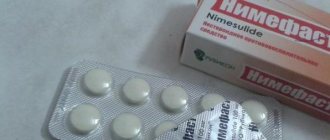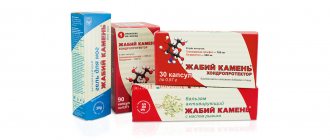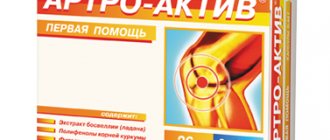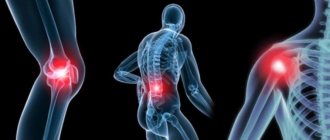Write a review
Reviews: 0
Manufacturers: Novartis Pharma GmbH
Active ingredients
- Calcitonin
Disease class
- Causalgia
- Hyperparathyroidism and other parathyroid [parathyroid] disorders
- Acute pancreatitis
- Immobilization syndrome (paraplegic)
- Postmenopausal osteoporosis
- Osteoporosis caused by immobility
- Drug-induced osteoporosis
- Other osteoporosis
- Paget's disease (bone) [osteitis deformans]
- Algoneurodystrophy
- Osteolysis
- Other specified bone lesions
- Bone disease, unspecified
- Osteopathy for other diseases classified elsewhere
- Vitamins not classified elsewhere
- Hypervitaminosis D
- Calcium metabolism disorders
- Menopause and menopause in women
Clinical and pharmacological group
- Not indicated. See instructions
Pharmacological action
- Hypocalcemic
Pharmacological group
- Correctors of bone and cartilage tissue metabolism
Pharmacodynamics and pharmacokinetics
Miacalcic contains the active ingredient calcitonin , which is a hormone produced by C-cells located in the thyroid gland. This hormone is characterized by antagonism to parathyroid hormone and, in parallel with it, takes part in regulating calcium metabolism in the human body.
The structure of all calcitonins is one chain consisting of 32 amino acids , as well as a ring, including 7 amino acid residues located at the N-terminus, with different sequences depending on the species. Due to the higher affinity of salmon calcitonin for the corresponding receptors (compared to mammalian calcitonins ), the strength and duration of its action are more pronounced.
Due to the influence of salmon calcitonin osteoclast activity is inhibited , which leads to a significant decrease in the metabolic rate in bone tissue and, in painful conditions characterized by increased resorption (for example, osteoporosis ), brings it to a normal level. Also noted is the analgesic effect of Miacalcic in relation to pain syndrome of bone origin, which appears, apparently, due to the direct effect of the drug on the central nervous system.
Already with a single use of the medicinal product Miacalcic in the form of an injection solution or nasal spray, the patient experiences a biological, clinically significant response, manifested by an increase in the excretion of calcium , sodium and phosphorus (due to weakening of tubular reabsorption ) and a decrease in the excretion of hydroxyproline .
Long-term intranasal or parenteral administration of Miacalcic leads to a significant decrease in the content of biochemical markers inherent in bone metabolism, including pyridinoline , bone alkaline phosphatase isoenzymes and serum C-telopeptides .
Parenteral administration of calcitonin reduces exocrine and gastric pancreatic secretion , which determines the effectiveness of Miacalcic in the treatment of acute pancreatitis .
When using Miacalcic nasal spray, there is a statistically significant increase (1-2%) mineral density in the lumbar vertebrae, determined in the first year of therapy and maintained for 5 years. In the femur, Miacalcic helps maintain normal mineral density .
The use of Miacalcic spray in a daily dosage of 200 IU led to a clinically and statistically significant decrease (36%) in the risk of fresh vertebral fractures , which was noted in the group of patients receiving combinatorial treatment with Miacalcic, calcium and vitamin D , in comparison with the group of patients receiving calcium supplements , vitamin D and placebo . In addition, in patients of the first group, a decrease in the incidence of multiple fractures of the spinal vertebrae by 35%.
With subcutaneous and intramuscular administration, the bioavailability of salmon calcitonin is approximately 70%, with intranasal application (in the nasal cavities) - 3-5%, in relation to the parenterally administered drug. Plasma Cmax with intramuscular administration is achieved within 60 minutes, with subcutaneous injection within 23 minutes, with intranasal administration, on average, after 10 minutes.
The apparent VSS of the drug is 0.15-0.3 l/kg. Binding to plasma proteins occurs by 30-40%. Up to 95% of calcitonin and its metabolic products are excreted by the kidneys, while only 2% of the active ingredient is excreted in unchanged form. T1/2 with intramuscular injection takes approximately 60 minutes, with subcutaneous injection - 60-90 minutes, with intranasal administration - 20 minutes.
With repeated intranasal injections of the drug, the accumulation of its active ingredient does not occur. In the case of using doses of Miacalcic that exceed the recommended ones, its higher concentrations are found in the plasma (as confirmed by an increase in AUC), while the relative bioavailability of the drug does not increase. Penetration of the drug through the placental barrier is not observed.
Determination of the plasma content of salmon calcitonin , like other polypeptide hormones , is not an indicator of its effectiveness, which should be determined by clinical indicators of the productivity of the therapy.
Pharmacodynamics
The hormone produced by the C-cells of the thyroid gland is an antagonist of parathyroid hormone and, together with it, participates in the regulation of calcium metabolism in the body.
The structure of all calcitonins is represented by one chain of 32 amino acids and a ring of 7 amino acid residues at the N-terminus, the sequence of which varies in different species. Since salmon calcitonin has a higher affinity for receptors (compared to mammalian calcitonins), its effect is most pronounced in both strength and duration.
By inhibiting osteoclast activity through its action on specific receptors, salmon calcitonin significantly reduces the rate of bone turnover to normal levels in conditions with an increased rate of resorption, such as osteoporosis. In both animals and humans, Miacalcic® has been shown to have analgesic activity for pain of bone origin, which appears to be due to a direct effect on the central nervous system.
After just a single use of Miacalcic® in the form of an injection solution or nasal spray, a person experiences a clinically significant biological response, which is manifested by an increase in urinary excretion of calcium, phosphorus and sodium (due to a decrease in their tubular reabsorption) and a decrease in hydroxyproline excretion.
Long-term parenteral or intranasal use of the drug Miacalcic® leads to a significant decrease in the level of biochemical markers of bone metabolism, such as pyridinoline, serum C-telopeptides (sCTX) and bone alkaline phosphatase isoenzymes.
Calcitonin when administered parenterally reduces gastric and exocrine pancreatic secretion. These properties of the drug Miacalcic® determine its effectiveness in the treatment of acute pancreatitis.
The use of Miacalcic® nasal spray leads to a statistically significant increase (by 1–2%) in bone mineral density in the lumbar vertebrae, which is determined already in the first year of treatment and lasts up to 5 years. The drug Miacalcic® ensures the maintenance of mineral density in the femur.
The use of Miacalcic® nasal spray at a dose of 200 IU/day leads to a statistically and clinically significant reduction (by 36%) in the risk of developing new vertebral fractures in the group of patients receiving Miacalcic® (in combination with vitamin D and calcium preparations), compared with a group of patients receiving placebo (in combination with the same drugs). In addition, in the group of patients treated with Miacalcic® (in combination with vitamin D and calcium preparations), compared with the group of patients receiving placebo (in combination with the same drugs), a 35% decrease in the incidence of multiple vertebral fractures was noted. Calcitonin reduces gastric and exocrine pancreatic secretion.
Indications for use
Miacalcic injection solution and spray are indicated for use in:
- deforming osteodystrophy (Paget's disease);
- sensation of bone pain associated with osteopenia and/or osteolysis ;
- postmenopausal osteoporosis (at early and late stages of development);
- neurodystrophic pathologies (Sudek's atrophy, algoneurodystrophy) caused by various predisposing and etiological factors, including: painful post-traumatic osteoporosis , glenohumeral syndrome , reflex dystrophy, causalgic syndrome , neurotrophic drug disorders.
Additionally, the injection solution is used for:
- primary senile osteoporosis in men and women;
- secondary osteoporosis , including that developed due to prolonged immobilization and treatment with glucocorticoids ;
- acute pancreatitis (as a means of additional therapy);
- hypercalcemic crisis and hypercalcemia caused by the following painful conditions: osteolysis provoked by malignant tumors ( myeloma , carcinoma of the lungs, breast, kidneys); prolonged immobilization ; hyperparathyroidism ; intoxication (poisoning) with vitamin D ; (used for the relief of acute conditions and for long-term therapy of chronic pathologies, until the effect of specific treatment of the underlying disease manifests itself).
Side effects
When using the injection solution and spray Miacalcic, undesirable side effects may occur such as: dizziness , nausea/vomiting, arthralgia , mild flushing of the facial skin with a feeling of warmth. Dizziness, nausea / vomiting and hot flashes were dose-dependent and were more often observed with intravenous administration of Miacalcic, compared with its subcutaneous or intramuscular use. During therapy using Miacalcic, chills and polyuria , which, as a rule, disappear on their own and only sometimes require a temporary reduction in the dosage of the drug.
Also, with varying frequency of manifestations, the use of Miacalcic can lead to the following negative phenomena.
Often:
- headache;
- arthralgia;
- dizziness;
- stomach ache;
- taste disorders;
- tides;
- nausea;
- increased fatigue ;
- diarrhea.
Sometimes:
- visual disturbances;
- arterial hypertension;
- swelling of the face;
- vomit;
- pain in muscles and bones;
- influenza-like syndrome;
- generalized and peripheral edema.
Rarely:
- hypersensitivity;
- polyuria;
- generalized rash;
- chills;
- itching;
- reactions at the injection site.
Rarely:
- anaphylactic shock;
- other anaphylactoid and anaphylactic reactions.
Additionally, the following side effects were observed when using Miacalcic spray.
Often:
- rhinitis;
- irritation;
- soreness in the nasal cavities;
- mucosal erythema;
- congestion;
- unpleasant odor;
- swelling of the mucous membrane;
- allergic rhinitis;
- sneezing;
- dryness in the nasal cavity;
- formation of excoriations in the nasal cavities.
Often:
- pharyngitis;
- nosebleeds;
- ulcerative rhinitis;
- sinusitis.
Sometimes:
- cough.
Instructions for use of Miacalcic (Method and dosage)
Miacalcic injection solution, instructions for use
Miacalcic in the form of an injection solution is intended for subcutaneous, intramuscular and intravenous administration.
For the treatment of osteoporosis, subcutaneous or intramuscular administration of the drug is indicated in a daily dosage of 50 IU or 100 IU every day or every 24 hours (depending on the severity of the disease). To prevent the progression of bone loss, it is recommended to prescribe vitamin D and calcium in adequate doses in parallel with Miacalcic.
For painful bone syndrome associated with osteopenia and/or osteolysis , daily administrations are prescribed in a daily dose of 100-200 IU. The drug can be administered by infusion (in saline solution), as well as by intramuscular or subcutaneous injections in a series of injections until satisfactory clinical efficacy is achieved. The dosage of Miacalcic should be adjusted taking into account the patient's response to therapy.
It may take several days analgesic effect to develop If long-term treatment is necessary, the initial daily dosage of the drug and/or the frequency of its use is usually reduced.
For Paget's disease, Miacalcic is administered intramuscularly and/or subcutaneously at a daily dosage of 100 IU, applied daily or every 24 hours. The minimum duration of therapy is 3 months. The dose of the drug is selected taking into account the patient's response to the treatment.
Emergency treatment of a hypercalcemic crisis is carried out in the form of infusion, which is most effective in relieving emergency and other severe painful conditions. In this case, the daily dose of Miacalcic is calculated per kilogram of the patient’s weight and is usually 5-10 IU/kg, dissolved in 500 ml of saline solution . The infusion is carried out over a minimum of 6 hours. Slow intravenous administration of Miacalcic is also allowed, dividing the daily dosage of the drug into 2-4 times.
Long-term treatment hypercalcemia is recommended to be carried out in the form of intramuscular or subcutaneous injections in a daily dosage of 5-10 IU/kg, used once or twice every 24 hours. The dosage regimen is adjusted based on the clinical dynamics of the patient’s condition and his biochemical parameters . If the required Miacalcic dose volume of 2 ml is exceeded, preference is given to intramuscular injections carried out in different places.
In the treatment of neurodystrophic pathologies, early diagnosis of the disease is extremely important. Treatment begins immediately after an accurate diagnosis. Miacalcic is prescribed in the form of intramuscular and/or subcutaneous injections in a daily dosage of 100 IU, administered over 2-4 weeks. Continuation of treatment is possible with the administration of the drug at 100 IU every 24 hours for up to 6 weeks (consistent with the dynamics of the patient’s painful condition).
Treatment of acute pancreatitis with the use of Miacalcic is carried out as part of a combinatorial conservative treatment. The drug is administered as an infusion at a dose of 300 IU dissolved in saline . Infusions are carried out over 24 hours for 6 days in a row.
Miacalcic spray, instructions for use
Miacalcic spray is intended for intranasal use (in the nasal cavity). It is recommended to administer the spray by alternating the nasal passages.
For the treatment of osteoporosis , a daily dose of Miacalcic is prescribed, amounting to 200 IU. To prevent the progression of bone loss, it is recommended to prescribe vitamin D and calcium in adequate doses in parallel with the spray. Treatment is carried out over a long period of time.
For painful bone syndrome associated with osteopenia and/or osteolysis , a spray is used in a daily dosage of 200-400 IU, administered daily. A dose of 200 IU can be used simultaneously. Higher dosages must be administered in several doses. The dose of Miacalcic spray should be adjusted according to the individual needs of the patient.
It may take several days analgesic effect to develop If long-term treatment is necessary, the initial daily dosage of the drug and/or the frequency of its use is usually reduced.
For Paget's disease, daily use of the spray is recommended at a daily dosage of 200 IU. Sometimes, at the beginning of therapy, a daily dose of 400 IU, administered in several doses, may be necessary. The minimum duration of treatment should be 3 months. The dosage is adjusted taking into account the personal needs of the patient.
Treatment with Miacalc for Paget's disease should be continued continuously for several months or even several years. When carrying out such therapy, a significant decrease in plasma alkaline phosphatase and renal excretion of hydroxyproline , sometimes to standard values. However, in some cases, an increase in these indicators was noted after their initial decrease. If such a clinical picture is detected, the doctor should consider the advisability of discontinuing treatment and its subsequent resumption.
Several months after completion of therapy, disorders of bone and tissue metabolism may occur again. In this case, a repeat course of treatment is required.
In the treatment of neurodystrophic pathologies, early diagnosis of the disease is extremely important. Treatment begins immediately after an accurate diagnosis. Miacalcic is prescribed in the form of a spray in a daily dose of 200 IU once daily for 2-4 weeks. Continuation of treatment is possible with the administration of the drug 200 IU every 24 hours for up to 6 weeks (consistent with the dynamics of the patient’s painful condition).
Experience with the use of Miacalcic injection solution and spray in pediatrics is quite limited, and therefore it is not possible to give recommendations for their use in this age group.
Significant experience with the use of both dosage forms of Miacalcic, used for the treatment of elderly patients, confirms the normal tolerability of the drugs by patients in this age group, as well as the absence of the need to adjust the dosage regimen. The same picture is observed in patients with / kidney pathologies , although targeted studies of the effect of Miacalcic on patients in these groups have not been conducted.
Device for administering nasal spray
The primary packaging of the spray used for further intranasal use is:
- a bottle containing a solution of the drug in a volume sufficient for at least 14 injections;
- a protective cap that protects the tip from contamination and the outlet from clogging;
- a tip intended for insertion into the nasal passage;
- a sprayer (piston), which is a moving part of the bottle used for the procedure of spraying the solution;
- the outlet is a small hole in the center of the tip through which the solution is injected;
- the tube is located inside the bottle and serves to supply the solution after pressing the sprayer;
- a dose counter showing the doses used; a window on the sprayer (on a full bottle the window is completely red).
Preparing the nasal spray for use
Shaking the bottle with the drug is not allowed, as this may cause the formation of air bubbles in the solution, which will lead to incorrect dosing of the drug.
The dosage counter window for unused spray should be red.
When using the spray for the first time, remove the protective cap from the tip of the sprayer and, holding the bottle vertically, make three preliminary presses on the piston to remove air from the tube. This procedure is carried out once to bring the spray into working condition. When removing air from the tube, slight splashing of the solution itself is allowed, which is provided by the manufacturer and does not affect the further number of doses.
You should pay attention to the color change in the counter window after each subsequent press on the piston. After the third preventive press, a green color should appear in the window, indicating that the device is ready for further use.
Method of using nasal spray
- To properly use Miacalcic nasal spray, the patient should tilt his head slightly forward and insert the tip of the spray into the nasal passage. Make sure that the tip of the nebulizer is positioned in line with the nasal passage to ensure even distribution of the drug.
- Press the piston once.
- Remove the tip from the nasal passage and take several active breaths through the nose to prevent the solution from leaking out.
- You should not clear your nasal passage immediately after using the drug.
- If the doctor prescribes 2 injections at a time, the second procedure is carried out in the other nasal passage.
- After using the spray, carefully wipe the spray tip with a dry, clean cloth and put the protective cap on it.
Nasal spray dose recording
Before using the spray, as well as after its use, it is necessary to mark the number in the dosage counter window, which should increase by one value after each subsequent injection of one dose of the drug. A bottle of nasal spray includes 14 full doses, but taking into account the supply of solution provided by the manufacturer, it is possible to carry out 2 additional sprays.
The appearance of the number 16 in the dose window means the complete absence of solution in the bottle. A slight residue of the drug at the bottom of the bottle cannot be used.
Additional warnings
Do not disassemble the spray device or attempt to enlarge the tip opening using a needle or other sharp object. Such interference will lead to serious disruption of the operation of the spraying device. If you have any doubts about the correct operation of the device, you should consult with a specialist at the pharmacy where the spray was purchased.
To ensure accurate dosage measurements, the vial of the drug should be stored and transported in an upright position. Shaking the bottle is not allowed. Sudden temperature changes should be avoided. The used bottle can be stored at room temperature for a maximum of 4 weeks.
Solution for injection Miacalcic (Miacalcic)
Instructions for medical use of the drug
Description of pharmacological action
Replenishes calcitonin deficiency, regulates calcium metabolism and bone metabolism. It is an antagonist of parathyroid hormone.
Indications for use
Common to both dosage forms are bone pain associated with osteolysis and/or osteopenia; — Paget's disease (osteitis deformans); - neurodystrophic diseases (synonyms - algoneurodystrophy, Sudeck's atrophy), caused by various etiological and predisposing factors, such as post-traumatic painful osteoporosis, reflex dystrophy, glenohumeral syndrome, causalgia, drug-induced neurotrophic disorders; - postmenopausal osteoporosis (both early and late stages). Additionally, for the drug Miacalcic® for parenteral administration - primary osteoporosis - senile osteoporosis in women and men; - secondary osteoporosis, in particular caused by glucocorticoid therapy or immobilization. - hypercalcemia and hypercalcemic crisis caused by the following factors; — osteolysis caused by malignant tumors (carcinoma of the breast, lungs, kidneys; multiple myeloma, etc.); - hyperparathyroidism; - immobilization; — vitamin D intoxication; - relief of emergency conditions and long-term treatment of chronic hypercalcemia - until the effect of specific therapy for the underlying disease is manifested; - acute pancreatitis (as part of combination therapy).
Release form
solution for injection 100 IU/ml; ampoule 1 ml, cardboard pack 5;
Pharmacodynamics
The hormone produced by the C-cells of the thyroid gland is an antagonist of parathyroid hormone and, together with it, participates in the regulation of calcium metabolism in the body. The structure of all calcitonins is represented by one chain of 32 amino acids and a ring of 7 amino acid residues at the N-terminus, the sequence of which varies in different species. Since salmon calcitonin has a higher affinity for receptors (compared to mammalian calcitonins), its effect is most pronounced in both strength and duration. By inhibiting osteoclast activity through its action on specific receptors, salmon calcitonin significantly reduces the rate of bone turnover to normal levels in conditions with an increased rate of resorption, such as osteoporosis. In both animals and humans, Miacalcic has been shown to have analgesic activity for pain of bone origin, which appears to be due to a direct effect on the central nervous system. After just a single use of the drug Miacalcic in the form of an injection solution or nasal spray, a person experiences a clinically significant biological response, which is manifested by an increase in urinary excretion of calcium, phosphorus and sodium (due to a decrease in their tubular reabsorption) and a decrease in the excretion of hydroxyproline. Long-term parenteral or intranasal use of the drug Miacalcic leads to a significant decrease in the level of biochemical markers of bone metabolism, such as pyridinoline, serum C-telopeptides (sCTX) and bone alkaline phosphatase isoenzymes. Calcitonin when administered parenterally reduces gastric and exocrine pancreatic secretion. These properties of the drug Miacalcic determine its effectiveness in the treatment of acute pancreatitis. The use of Miacalcic nasal spray leads to a statistically significant increase (by 1–2%) in bone mineral density in the lumbar vertebrae, which is determined already in the first year of treatment and lasts up to 5 years. The drug Miacalcic ensures the maintenance of mineral density in the femur. The use of the drug Miacalcic nasal spray at a dose of 200 IU/day leads to a statistically and clinically significant reduction (by 36%) in the risk of developing new vertebral fractures in the group of patients receiving the drug Miacalcic (in combination with vitamin D and calcium preparations), compared with the group patients receiving placebo (in combination with the same drugs). In addition, in the group of patients treated with Miacalcic (in combination with vitamin D and calcium preparations), compared with the group of patients receiving placebo (in combination with the same drugs), a 35% decrease in the incidence of multiple vertebral fractures was noted. Calcitonin reduces gastric and exocrine pancreatic secretion.
Pharmacokinetics
The bioavailability of salmon calcitonin, both intramuscularly and subcutaneously, is about 70%, and when administered intranasally, it is 3–5% relative to the bioavailability of the drug administered parenterally. Cmax of the drug in plasma is achieved within 1 hour, and with subcutaneous administration - within approximately 23 minutes. The drug Miacalcic is rapidly absorbed through the nasal mucosa and its Cmax in plasma is reached within the first hour (on average, about 10 minutes). Apparent VSS is 0.15–0.3 L/kg. Plasma protein binding is 30–40%. Up to 95% of calcitonin and its metabolites are excreted in the urine, with only 2% unchanged. T1/2 of the drug is about 1 hour with intramuscular administration; 1–1.5 hours for subcutaneous administration and about 20 minutes for intranasal administration. With repeated administration of the drug intranasally, no accumulation was observed. When the drug was used in doses higher than recommended, its concentrations in the blood were higher (as confirmed by an increase in AUC values), but the relative bioavailability did not increase. Determining the concentration of salmon calcitonin in plasma, as well as the concentrations of other polypeptide hormones, seems to be of little value, since the level of concentrations cannot predict the therapeutic effectiveness of the drug. Thus, the activity of the drug Miacalcic should be assessed by clinical indicators of effectiveness. Salmon calcitonin does not cross the placental barrier in humans.
Use during pregnancy
In experimental studies, the drug Miacalcic did not have embryotoxic or teratogenic effects and did not penetrate the placental barrier. However, there are no clinical data on the safety of using the drug Miacalcic during pregnancy. In this regard, the drug should not be used in women during pregnancy. It is unknown whether salmon calcitonin passes into breast milk in humans, so it is recommended that you avoid breastfeeding during drug therapy.
Contraindications for use
Hypersensitivity to synthetic salmon calcitonin or any other component of the drug.
Side effects
Common to both dosage forms Undesirable effects such as nausea, vomiting, dizziness, slight flushing of the face, accompanied by a feeling of warmth, and arthralgia have been reported. Nausea, vomiting, dizziness, and hot flashes are dose dependent and occur more frequently with intravenous than with intramuscular or subcutaneous administration. While using the drug Miacalcic®, polyuria and chills may develop, which usually disappear on their own, and only in some cases require a temporary reduction in the dose of the drug. The incidence of adverse events possibly related to the use of the drug is assessed as follows: very often (≥1/10); often (≥1/100, From the immune system: rarely - hypersensitivity; very rarely - anaphylactic or anaphylactoid reactions, anaphylactic shock. From the nervous system: often - headache, dizziness. From the sensory organs: often - taste disturbances; sometimes - visual disturbances. From the cardiovascular system: often - hot flashes; sometimes - arterial hypertension. From the gastrointestinal tract: often - nausea, abdominal pain, diarrhea; sometimes - vomiting. From the skin and subcutaneous tissue: rarely - generalized rash. From the musculoskeletal system and connective tissue: often - arthralgia; sometimes - pain in bones and muscles From the urinary system: rarely - polyuria. From the body as a whole and local reactions: often - increased fatigue; sometimes - flu-like syndrome, edema face, peripheral and generalized edema; rarely - chills, reactions at the injection site, itching. Additionally for the drug Miacalcic® nasal From the respiratory tract: very often - pain in the nasal cavity, congestion, swelling of the nasal mucosa, sneezing, rhinitis, dryness in the nasal cavity, allergic rhinitis, erythema of the nasal mucosa, irritation, unpleasant odor, formation of excoriations in the nasal cavity; often - nosebleeds, sinusitis, ulcerative rhinitis, pharyngitis; sometimes - cough.
Directions for use and doses
S/c, i/m, i/v. Osteoporosis. The drug is administered subcutaneously or intramuscularly at a daily dose of 50 or 100 IU daily or every other day (depending on the severity of the disease). In order to prevent progressive bone loss, it is recommended to prescribe adequate doses of calcium and vitamin D simultaneously with the use of Miacalcic. Bone pain associated with osteolysis and/or osteopenia. The daily dose is 100–200 IU daily. The drug is administered intravenously, dropwise (in saline solution) or subcutaneously or intramuscularly in several injections until a satisfactory clinical effect is achieved. The dose should be adjusted based on the patient's response to treatment. It may take several days to achieve the full analgesic effect. When carrying out long-term therapy, the initial daily dose is usually reduced and/or the interval between administrations is increased. Paget's disease. SC or IM in a daily dose of 100 IU daily or every other day. The duration of treatment is at least 3 months; if necessary it can be larger. The dose should be adjusted based on the patient's response to treatment. Hypercalcemia. Emergency treatment of hypercalcemic crisis. Since IV infusion is the most effective route of administration, it should be preferred for the treatment of emergency and other serious conditions. The drug Miacalcic is administered intravenously over a period of at least 6 hours, at a daily dose of 5-10 IU/kg in 500 ml of saline. It is also possible to administer a slow intravenous jet, in which the daily dose should be divided into 2-4 injections throughout the day. Long-term treatment for chronic hypercalcemia. Daily subcutaneously or intramuscularly at a daily dose of 5–10 IU/kg once or in 2 administrations. The dosage regimen should be adjusted taking into account the dynamics of the patient’s clinical condition and biochemical parameters. If the volume of the required dose of Miacalcic exceeds 2 ml, then intramuscular injections are preferable, which should be carried out in different places. Neurodystrophic diseases. Early diagnosis is extremely important. Treatment should begin immediately after confirmation of the diagnosis. SC or IM in a daily dose of 100 IU for 2–4 weeks. It is possible to continue treatment with the administration of 100 IU every other day for up to 6 weeks, depending on the dynamics of the patient’s condition. Acute pancreatitis. The drug Miacalcic is used as part of a combined conservative treatment. Administer intravenously at a dose of 300 IU (in saline) over 24 hours for up to 6 days in a row. Intranasally. It is recommended to administer Miacalcic nasal spray alternately into one or the other nasal passage. For the treatment of osteoporosis, the recommended dose is 200 IU/day. In order to prevent progressive bone loss, it is recommended to prescribe adequate doses of calcium and vitamin D simultaneously with the use of Miacalcic in the form of a nasal spray. Treatment should be carried out over a long period of time. Bone pain associated with osteolysis and/or osteopenia. The daily dose is 200–400 IU daily. A daily dose of 200 IU can be administered at a time. Higher doses should be divided into several administrations. The dose should be adjusted to suit the individual needs of the patient. It may take several days to achieve the full analgesic effect. When carrying out long-term therapy, the initial daily dose is usually reduced and/or the interval between administrations is increased. Paget's disease. The drug is prescribed daily at a daily dose of 200 IU. In some cases, at the beginning of treatment, a dose of 400 IU/day may be required, given in several doses. The duration of treatment is at least 3 months; if necessary it can be larger. The dose should be adjusted to suit the individual needs of the patient. Note. In Paget's disease, the duration of treatment with Miacalcic should range from several months to several years. During treatment, there is a significant decrease in the concentration of alkaline phosphatase in the blood and the excretion of hydroxyproline in the urine, sometimes to normal values. However, in some cases, after an initial decrease, the values of these indicators may increase again. In these cases, the physician, guided by the clinical picture, must decide whether treatment should be discontinued and when it can be resumed. One or several months after discontinuation of treatment, bone metabolism disorders may recur; in this case, a new course will be required. Neurodystrophic diseases. Early diagnosis is extremely important. Treatment should begin immediately after confirmation of the diagnosis. Prescribe 200 IU/day (in one administration) daily for 2–4 weeks. An additional dose of 200 IU is possible every other day for up to 6 weeks, depending on the dynamics of the patient’s condition. Use in children. Experience with the use of Miacalcic solution for parenteral administration and nasal spray in children is limited, and therefore it is not possible to make recommendations for this age group. Use in elderly patients and certain groups of patients. Extensive experience with the use of Miacalcic solution for parenteral administration and nasal spray in elderly patients indicates that in this age group there was no deterioration in tolerability of the drug or the need to change the dosage regimen. The same applies to patients with decreased kidney or liver function, although studies have not been conducted specifically for these groups of patients.
Overdose
Symptoms: signs of hypocalcemia (paresthesia, muscle twitching, etc.). With subcutaneous administration of calcitonin (salmon) at a dose of 1000 IU, only nausea and vomiting were observed. At doses up to 32 IU/kg/day for 1–2 days, no additional side effects were reported. Data from long-term use at high doses are insufficient to assess toxicity. With intranasal use, cases of overdose and serious adverse reactions associated with the use of high doses were not observed. There are reports of a single application of salmon calcitonin nasal spray at a dose of up to 1600 IU and use at a dose of 800 IU/day for 3 days, with no serious side effects noted. The development of hypocalcemic tetany has not been reported with the use of the nasal spray. Treatment: symptomatic. Parenteral administration of calcium gluconate.
Interactions with other drugs
No studies have been conducted to evaluate the interaction of drugs with salmon calcitonin. No drug interactions have been reported with salmon calcitonin. When treating hypercalcemia, simultaneous use of calcium-containing drugs or vitamin D may counteract the effect of calcitonin; When treating other conditions, calcium-containing drugs can be taken 4 hours after calcitonin.
Special instructions for use
A doctor or nurse should provide detailed instructions to patients who are self-administering subcutaneous injections of the drug. Before using the drug Miacalcic, you should visually check the condition of the ampoule and solution. The ampoule of the drug should not be damaged, the solution should be transparent, colorless and free of foreign inclusions. After a single use of the drug Miacalcic, the unused solution of the drug remaining in the ampoule should be disposed of. Before subcutaneous or intramuscular administration, the Miacalcic solution should be warmed to room temperature. With long-term use of the drug Miacalcic, patients may develop antibodies to calcitonin; however, this phenomenon does not usually affect clinical effectiveness. The "escape" phenomenon, observed mainly in patients with Paget's disease receiving Miacalcic for a long time, is probably due to saturation of binding sites, and not the formation of antibodies. After a break in treatment, the therapeutic effect of Miacalcic is restored. In Paget's disease, as well as in other chronic diseases with an increased level of bone turnover, the duration of treatment with Miacalcic should range from several months to several years. During treatment, the concentration of alkaline phosphatase in the blood and the excretion of hydroxyproline in the urine decrease and often normalize. However, it should be borne in mind that in some cases, after an initial decrease, the values of these indicators may increase again. In these cases, when deciding whether to cancel treatment or when to resume it, the doctor should be guided by the clinical picture. One or several months after discontinuation of treatment, bone metabolism disorders may occur again, in which case a new course of treatment with Miacalcic will be required. Since salmon calcitonin is a peptide, there is a potential for systemic allergic reactions. There are reports of allergic reactions, including isolated cases of anaphylactic shock, that occurred in patients receiving Miacalcic. If a patient is suspected of hypersensitivity to salmon calcitonin, before starting treatment, skin tests should be performed using a diluted sterile solution of the drug Miacalcic. The drug Miacalcic, solution for injection, contains virtually no sodium (less than 23 mg). Impact on the ability to drive vehicles and operate machinery. The effect of the drug Miacalcic on the ability to drive vehicles and operate machinery has not been studied. Some side effects of the drug, such as dizziness and visual disturbances, may adversely affect the ability to drive a car and perform potentially dangerous activities that require increased concentration and speed of psychomotor reactions. Note. With long-term therapy, the formation of antibodies to calcitonin is possible, but this usually does not affect the clinical effectiveness. The habituation phenomenon, which is observed mainly in patients with Paget's disease receiving long-term therapy, may be a consequence of saturation of binding sites and is apparently not related to the formation of antibodies. The therapeutic effect of the drug Miacalcic is restored after a break in treatment.
Storage conditions
List B.: At a temperature of 2–8 °C.
Best before date
60 months
ATX classification:
H Hormones for systemic use (excluding sex hormones)
H05 Drugs that regulate calcium metabolism
H05B Antiparathyroid hormones
H05BA Calcitonin preparations
H05BA01 Calcitonin (salmon synthetic)
Overdose
Negative symptoms of overdose with parenteral administration of Miacalcic are manifested by hot flashes , nausea/vomiting and dizziness , which are dose-dependent. When using Miacalcic intranasally in the form of a spray, similar phenomena can be expected. However, there are reports of cases of using Miacalcic spray in single doses of up to 1600 IU and in daily doses of 800 IU, used for 3 days, which did not lead to any serious negative effects. Cases of overdose with Miacalcic spray are occasional. An overdose of salmon calcitonin may cause hypocalcemia , accompanied by muscle twitching and paresthesia .
salmon calcitonin overdose should be appropriate to the negative symptoms observed. In case of development of hypocalcemia, of calcium gluconate is indicated .
Miacalcic
During the first administration of the drug (or with several initial administrations), hypocalcemia may develop, sometimes accompanied by tetany, therefore, for emergency assistance, the drug Ca2+ (calcium gluconate) for parenteral administration should be available.
Calcitonin solution should be prepared immediately before administration. The prepared solution can be used within 6 hours.
With long-term use of salmon calcitonin, which is a foreign protein for humans, the formation of antibodies is possible. With a duration of use of up to 2 years, the appearance of antibodies was noted in 30-60% of patients, the formation of resistance to treatment was observed in 5-15%. Longer treatment is possible only in those patients who have not developed antibodies. When using synthetic human calcitonin, the formation of antibodies is rarely observed, which makes it possible to carry out a long course of treatment that does not lead to the development of resistance.
In Paget's disease, during treatment with calcitonin, there is a decrease in the concentration of alkaline phosphatase in the blood serum (reflecting a decrease in osteogenesis) and a decrease in the excretion of hydroxyproline in the urine (reflecting a decrease in bone resorption, in particular the breakdown of collagen). The most pronounced decrease in the values of these indicators, reflecting the positive effect of treatment, is observed after 6-24 months of continuous treatment. Monitoring the concentration of alkaline phosphatase in the blood serum and daily urinary excretion of hydroxyproline should be carried out before treatment, regularly in the first 3 months and every 3-6 months during long-term treatment.
During the treatment of patients with hypercalcemia, systematic monitoring of Ca2+ concentration in the blood serum is indicated.
Experience with the use of nasal aerosol in children is limited, and therefore the use of the drug in this age group is currently not possible.
The drug is excreted in breast milk; if it is necessary to prescribe the drug during lactation, breastfeeding should be stopped.
It is recommended to be careful when driving vehicles and when working with moving machinery.
Before using the nasal aerosol, it should be stored in the refrigerator at a temperature of 2-8 degrees C in an upright position to ensure proper spraying; do not freeze. After starting use, it should be stored at a temperature not exceeding 25 degrees C for no more than 4 weeks (do not store in the refrigerator).
special instructions
A physician or nurse experienced in performing subcutaneous injections should instruct the patient in the proper technique for performing such procedures independently.
Miacalcic injection solution contains less than 23 mg sodium .
Before injecting Miacalcic, it is necessary to visually examine the condition of the solution and ampoule of the drug. It is allowed to use a colorless, transparent injection solution that does not contain foreign inclusions, enclosed in an intact ampoule. After a one-time use of Miacalcic, the remainder of the unused solution in the ampoule should be disposed of.
Before administering Miacalcic intramuscularly or subcutaneously, the ampoule with the injection solution should be warmed to room temperature.
With prolonged use of any of the dosage forms of the drug Miacalcic, the formation of antibodies to calcitonin , which, as a rule, did not affect the overall picture of the clinical effectiveness of the drug. The phenomenon of "addiction", mainly observed in patients with Paget's disease , using Miacalcic for a long period of time, is probably due to the saturation of drug binding sites, and not the release of antibodies to calcitonin . After a break in therapy, the effectiveness of Miacalcic is completely restored.
Treatment of Paget's disease , like other chronic pathologies that occur with increased bone turnover , should be long-term and take several months or even several years.
During Miacalc therapy, plasma alkaline phosphatase and renal excretion of hydroxyproline are significantly reduced or normalized. However, in some cases, an increase in these indicators was noted after their initial decrease. If such a clinical picture is identified, the doctor should consider the advisability of discontinuing treatment and its subsequent resumption, consistent with the clinical picture of the disease.
Several months after completion of therapy, disorders of bone and tissue metabolism may occur again. In this case, a repeat course of treatment is required.
Due to the peptide basis of salmon calcitonin , when using Miacalcic, there is a possibility of the formation of systemic allergic manifestations . There is information about the development of allergic reactions , including isolated cases of anaphylactic shock . If a patient is suspected of hypersensitivity to salmon calcitonin , skin tests using a sterile diluted solution of Miacalcic should be prescribed before starting therapy.
Directions for use and doses
S/c, i/m, i/v.
Osteoporosis. The drug is administered subcutaneously or intramuscularly at a daily dose of 50 or 100 IU daily or every other day (depending on the severity of the disease). In order to prevent progressive bone loss, it is recommended to prescribe adequate doses of calcium and vitamin D simultaneously with the use of Miacalcic®.
Bone pain associated with osteolysis and/or osteopenia. The daily dose is 100–200 IU daily. The drug is administered intravenously, dropwise (in saline solution) or subcutaneously or intramuscularly in several injections until a satisfactory clinical effect is achieved. The dose should be adjusted based on the patient's response to treatment.
It may take several days to achieve the full analgesic effect. When carrying out long-term therapy, the initial daily dose is usually reduced and/or the interval between administrations is increased.
Paget's disease. SC or IM in a daily dose of 100 IU daily or every other day. The duration of treatment is at least 3 months; if necessary it can be larger. The dose should be adjusted based on the patient's response to treatment.
Hypercalcemia. Emergency treatment of hypercalcemic crisis. Since IV infusion is the most effective route of administration, it should be preferred for the treatment of emergency and other serious conditions.
The drug Miacalcic® is administered intravenously over a period of at least 6 hours, at a daily dose of 5-10 IU/kg in 500 ml of physiological solution. It is also possible to administer a slow intravenous jet, in which the daily dose should be divided into 2-4 injections throughout the day.
Long-term treatment for chronic hypercalcemia. Daily subcutaneously or intramuscularly at a daily dose of 5–10 IU/kg once or in 2 administrations. The dosage regimen should be adjusted taking into account the dynamics of the patient’s clinical condition and biochemical parameters. If the volume of the required dose of Miacalcic® exceeds 2 ml, then intramuscular injections are preferable, which should be carried out in different places.
Neurodystrophic diseases. Early diagnosis is extremely important. Treatment should begin immediately after confirmation of the diagnosis. SC or IM in a daily dose of 100 IU for 2–4 weeks. It is possible to continue treatment with the administration of 100 IU every other day for up to 6 weeks, depending on the dynamics of the patient’s condition.
Acute pancreatitis. The drug Miacalcic® is used as part of a combined conservative treatment. Administer intravenously at a dose of 300 IU (in saline) over 24 hours for up to 6 days in a row.
Intranasally. It is recommended to administer Miacalcic® nasal spray alternately into one or the other nasal passage.
For the treatment of osteoporosis, the recommended dose is 200 IU/day. In order to prevent progressive bone loss, it is recommended to prescribe adequate doses of calcium and vitamin D simultaneously with the use of Miacalcic® in the form of a nasal spray. Treatment should be carried out over a long period of time.
Bone pain associated with osteolysis and/or osteopenia. The daily dose is 200–400 IU daily. A daily dose of 200 IU can be administered at a time. Higher doses should be divided into several administrations. The dose should be adjusted to suit the individual needs of the patient.
It may take several days to achieve the full analgesic effect. When carrying out long-term therapy, the initial daily dose is usually reduced and/or the interval between administrations is increased.
Paget's disease. The drug is prescribed daily at a daily dose of 200 IU. In some cases, at the beginning of treatment, a dose of 400 IU/day may be required, given in several doses. The duration of treatment is at least 3 months; if necessary it can be larger. The dose should be adjusted to suit the individual needs of the patient.
Note. In Paget's disease, the duration of treatment with Miacalcic® should range from several months to several years. During treatment, there is a significant decrease in the concentration of alkaline phosphatase in the blood and the excretion of hydroxyproline in the urine, sometimes to normal values. However, in some cases, after an initial decrease, the values of these indicators may increase again. In these cases, the doctor, guided by the clinical picture, must decide whether treatment should be discontinued and when it can be resumed.
One or several months after discontinuation of treatment, bone metabolism disorders may recur; in this case, a new course will be required.
Neurodystrophic diseases. Early diagnosis is extremely important. Treatment should begin immediately after confirmation of the diagnosis. Prescribe 200 IU/day (in one administration) daily for 2–4 weeks. An additional dose of 200 IU is possible every other day for up to 6 weeks, depending on the dynamics of the patient’s condition.
Use in children. Experience with the use of Miacalcic® solution for parenteral administration and nasal spray in children is limited, and therefore it is not possible to make recommendations for this age group.
Use in elderly patients and certain groups of patients. Extensive experience with the use of Miacalcic® solution for parenteral administration and nasal spray in elderly patients indicates that in this age group there was no deterioration in tolerability of the drug or the need to change the dosage regimen. The same applies to patients with decreased kidney or liver function, although studies have not been conducted specifically for these groups of patients.
Nasal spray device and instructions for its use
Nasal spray device
1. Protective cap - protects the tip (nozzle) from contamination and the outlet from clogging. After the drug is administered, be sure to put on the protective cap.
2. Outlet - a small hole through which the drug solution is sprayed out.
3. Tip - a device (tube) that is inserted into the nasal passage.
4. Piston - part of the bottle, by pressing which the spray device is activated.
5. Dose counter - a window that shows doses. On a spray that has not yet been used, the window is red. When you start using the drug, the window will show different colors and numbers (see below for more details).
6. Tube - the tube located inside the bottle serves to supply the drug after pressing the pump.
7. Bottle - contains the drug in the form of a solution in an amount sufficient for at least 14 injections.
Method of preparing nasal spray for use
You should never shake the bottle, because... this may cause air bubbles to form inside the vial, resulting in incorrect dosing of the drug.
An unused nasal spray will have a red dose counter window. First, remove the protective cap.
When using for the first time, holding the device with one or two hands strictly vertically, press the piston 3 times, which will allow the air to escape from the tube. This only needs to be done once to bring the device into working condition. You should not worry if a small amount of solution splashes out along with the air (this is intended and does not affect the subsequent number of doses).
Please note that after each successive press of the piston, the color of the dose counter window will change.
After the third press, the window should turn green, which means the device is ready for operation.
Thus, the nasal spray is ready for use.
Method of using nasal spray
Slightly tilt your head forward and insert the tip into the nasal passage. Make sure that the tip is in line with the nasal passage, which will ensure a more even distribution of the solution.
Press the piston 1 time.
Remove the tip from your nose and take several vigorous breaths through your nose to prevent the drug from leaking out.
You should not clear your nose immediately after using the drug.
If the doctor prescribed 2 injections at one time, then the second injection should be done in the other nasal passage.
Gently wipe the tip with a clean, dry cloth. Place the protective cap on the tip.
Checking the dose count
Before and after using the spray, you must check the number in the dose counter window. After each use of the nasal spray, the number in the window will change. If 1 dose is administered at a time, the previous value is increased by 1. The nasal spray contains 14 full doses. Since there is always a remainder of the solution in the vial, it is possible to obtain 2 additional doses.
When the number 16 appears in the window, this will mean that the drug has run out.
At the bottom of the bottle you can see a very slight residue of the solution; it is not to be used, it is provided for.
Additional warnings
Never try to enlarge the sprayer opening with a needle or other sharp object. This will lead to complete disruption of the device. The pump should not be disassembled. If you have any doubts about the operation of the device, you should consult the place where the drug was purchased. To ensure correct dosage measurements, store and carry the vial in an upright position. Do not shake the bottle. Avoid sudden changes in temperature. The opened bottle should be stored at room temperature. It is suitable for use for a maximum of 4 weeks.
During pregnancy and lactation
In the course of experimental studies, teratogenic or embryotoxic effects of Miacalcic were noted, nor was its penetration through the placental barrier . However, there are no clinical data on the safety of using Miacalcic for the treatment of pregnant women. As a result, it is not recommended to prescribe any of the dosage forms of this drug during pregnancy .
salmon calcitonin passes into the milk of a nursing mother has not been established. In this regard, Miacalcic should not breastfeeding
Reviews of Miacalcic
On the Internet you can mainly find reviews about Miacalcic spray and much less often reviews about the injection solution of this drug. Quite a varied assessment by patients of the effects of Miacalcic does not make it possible to draw an unambiguous conclusion about the effectiveness and safety of its use. For some, this drug is completely suitable, for others, due to severe side effects ( nausea / vomiting , hot flashes , dizziness ), it only harms others.
Also, you may come across references to the ability of Miacalcic to cause cancer , although official confirmation of this phenomenon has not been provided. If it is necessary to use drugs like Miacalcic, the patient should listen to the opinion of a doctor whom he completely trusts or consult with several independent specialists.
Similar drugs:
- Calcitonin Aerosol
- Miacalcic Nasal spray
** The Drug Directory is intended for informational purposes only. For more complete information, please refer to the manufacturer's instructions. Do not self-medicate; Before starting to use Miacalcic, you should consult a doctor. EUROLAB is not responsible for the consequences caused by the use of information posted on the portal. Any information on the site does not replace medical advice and cannot serve as a guarantee of the positive effect of the drug.
Are you interested in the drug Miacalcic? Do you want to know more detailed information or do you need a doctor's examination? Or do you need an inspection? You can make an appointment with a doctor - the Euro lab is always at your service! The best doctors will examine you, advise you, provide the necessary assistance and make a diagnosis. You can also call a doctor at home . Euro lab clinic is open for you around the clock.
** Attention! The information presented in this medication guide is intended for medical professionals and should not be used as a basis for self-medication. The description of the drug Miacalcic is provided for informational purposes and is not intended for prescribing treatment without the participation of a doctor. Patients need to consult a specialist!
If you are interested in any other drugs and medications, their descriptions and instructions for use, information about the composition and form of release, indications for use and side effects, methods of use, prices and reviews of drugs, or you have any other questions and suggestions - write to us, we will definitely try to help you.










